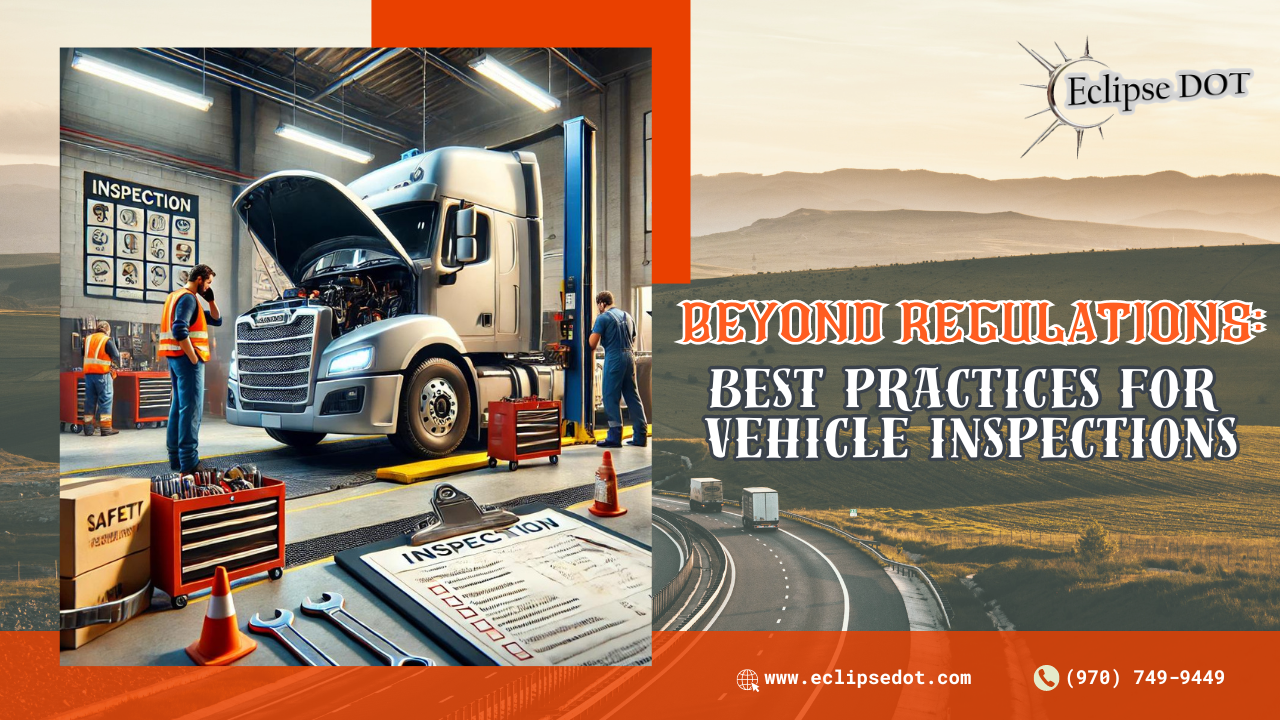Alright folks, buckle up! We’re diving into the exciting world of vehicle inspections for commercial motor vehicles (CMVs). I promise, it’s more thrilling than a rollercoaster—especially when it saves you from legal headaches.
The Importance of Vehicle Inspections
Vehicle inspections might not sound like the most glamorous part of the trucking world, but they are crucial. Inspections are your first line of defense against potential issues that could cause accidents, lead to costly repairs, or even result in legal troubles. By conducting thorough inspections, you’re not just complying with federal regulations; you’re ensuring the safety of your drivers and everyone else on the road.
Federal Regulations on Vehicle Inspections
Federal regulations mandate that you must perform a post-trip inspection, but not necessarily a pre-trip one. However, before hitting the road, the driver must ensure the truck is safe and roadworthy. Think of it like checking if your coffee is hot before taking that first sip. Trust me, it’s important!
These regulations are designed to ensure that any issues identified during a trip are noted and addressed before the vehicle is used again. It’s all about maintaining the safety and integrity of the vehicle, which ultimately protects your drivers, your cargo, and other road users.
Why Pre-Trip Inspections are Just as Important
Now, here’s our two cents: conduct both pre and post-trip inspections on every CMV. While post-trip inspections are required by law, pre-trip inspections are equally critical. They help identify issues before the vehicle hits the road, reducing the risk of breakdowns or accidents. Pre-trip inspections are like a warm-up for your vehicle, ensuring everything is in working order before embarking on a journey.
Skipping pre-trip inspections might save a few minutes, but it could cost you much more in the long run. Imagine finding out about a brake issue while barreling down the highway. Not a pleasant thought, right? Catching these issues before you start the trip can save lives and prevent costly repairs.
Paperwork: Keeping It Simple and Compliant
And don’t worry about drowning in paperwork. Thanks to the Paperwork Reduction Act, you only need to jot down the issues you find. This means you don’t have to document every single inspection—only when you spot a problem. This approach not only keeps you compliant but also saves you from an avalanche of paperwork.
However, it’s important to have a robust system for documenting and addressing any issues found. This documentation serves as a record that you’ve identified and corrected problems, which is essential if you ever face an audit or legal inquiry.
The Three-Signature Rule
If you do spot a problem during your vehicle inspection, the inspection sheet needs three signatures: the driver who found it, the safety person who decides if it’s a safety issue, and the mechanic who fixes it and another driver confirming it’s good to go. This process ensures accountability and confirms that the issue has been properly addressed before the vehicle is back on the road.
Here’s a quick breakdown of why each signature is important:
- Driver’s Signature: This marks the discovery of the problem and ensures the driver is taking responsibility for reporting it.
- Safety Person’s Signature: This verifies whether the issue is a safety concern that needs immediate attention.
- Mechanic’s Signature and Confirmation by Another Driver: This confirms that the problem has been fixed correctly and the vehicle is safe to operate again.
This thorough documentation process helps maintain a high standard of safety and ensures that all issues are tracked and resolved efficiently.
Retention of Inspection Records
Any documented problems must be kept on file for a minimum of 90 days. But here’s the kicker—if you only keep bad inspections, it might look like you’re neglecting maintenance. To cover your bases, keep both good and bad inspections. This shows you’re on top of repairs like a boss.
Keeping all inspection records, both good and bad, provides a complete picture of your vehicle’s maintenance history. It shows that you’re proactive about vehicle safety and diligent about addressing issues as they arise. This can be a lifesaver if you ever face a legal challenge or audit.
Avoiding Negligence Claims
If you only keep records of bad inspections, it could look like you’re not maintaining your vehicles properly. This can be a major issue if something goes wrong and you end up in court. Lawyers love to see patterns, and if the only pattern they see is one of neglect, you’re in trouble.
To avoid this, keep a mix of good and bad inspections. This shows that you’re actively maintaining your vehicles and addressing issues promptly. It’s like having a balanced diet for your paperwork—showing a healthy mix of good practices and necessary repairs.
Applying the Rules to All Vehicles
Whether you’re driving a big rig or a smaller non-CDL truck, the rules are the same. Those smaller trucks might seem less intimidating, but don’t be fooled. The regulations apply to all commercial vehicles, regardless of size or CDL requirements. Staying proactive with your vehicle inspections is crucial.
Non-CDL vehicles might feel more like your everyday car, but they are still commercial vehicles and must adhere to the same inspection regulations. This means you should conduct thorough pre and post-trip inspections, document any issues, and keep records just as you would for larger vehicles.
Benefits of Regular Vehicle Inspections
Regular vehicle inspections are not just about compliance—they offer several tangible benefits:
- Safety: Regular inspections help identify and fix issues before they become serious problems, ensuring the safety of your drivers and other road users.
- Cost Savings: Early detection of issues can save you money on repairs and prevent costly breakdowns.
- Efficiency: Well-maintained vehicles are more efficient, reducing downtime and keeping your fleet running smoothly.
- Reputation: A commitment to vehicle safety and maintenance enhances your company’s reputation, showing clients and partners that you prioritize safety and reliability.
Creating a Culture of Safety
Promoting a culture of safety within your organization is essential. Encourage drivers to take inspections seriously and report any issues immediately. Provide training on how to conduct thorough inspections and why they are important.
Recognize and reward drivers who consistently perform good inspections and report issues. This positive reinforcement can go a long way in building a team that values safety and takes pride in maintaining their vehicles.
Using Technology to Streamline Inspections
In today’s digital age, technology can be a powerful ally in streamlining vehicle inspections. Consider using electronic inspection forms and apps that make it easier to document and track issues. These tools can save time, reduce paperwork, and provide real-time data on the condition of your fleet.
Electronic inspection systems can also generate alerts and reminders for scheduled maintenance, helping you stay on top of vehicle upkeep. This proactive approach can prevent issues from escalating and keep your fleet in optimal condition.
Need Sample Inspection Sheets?
If you’re wondering how to get started or looking for a template, we’ve got you covered. Need sample inspection sheets? Just holler! We’re here to help you navigate the compliance maze and keep your fleet rolling smoothly.
Our sample inspection sheets are designed to make the process straightforward and ensure you cover all the necessary checks. They can be customized to fit your specific needs and help you stay organized and compliant.
Got Questions? We’ve Got Answers!
Vehicle inspections might seem like a chore, but they are a vital part of fleet management. Got questions? Feel free to reach out. We’re always ready to assist with any compliance queries you might have! Whether it’s understanding regulations, implementing best practices, or troubleshooting issues, we’re here to help.
Remember, staying proactive with vehicle inspections is not just about following the rules—it’s about ensuring the safety and efficiency of your operations. So, let’s keep those trucks in top shape and the roads safe for everyone.
Gain exclusive access to our CDL & DOT Compliance articles with a trial at DOTDocs.com. And don’t forget to claim your FREE micro audit at THE ECLIPSE DOT MICRO AUDIT. Ready for seamless operations? Discover the difference today!


